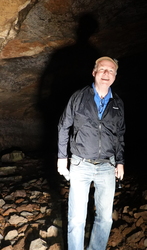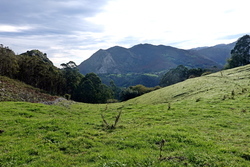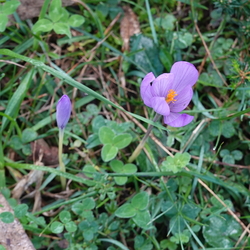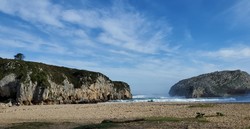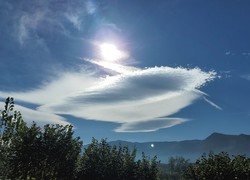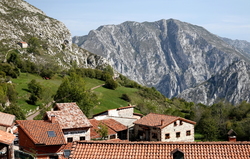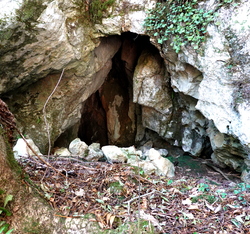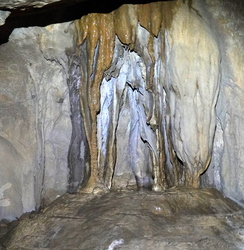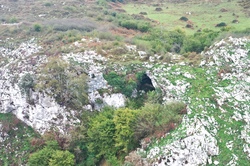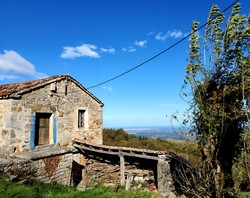

Introduction
Site list (GPS fixes) Walks (GPS tracks) Video clips Panoramas
Electronic projects:
Bat detector
Lamp tests
µ-controlled lamp
SEPIC-based lamp
ISP isolators
Making SMT boards
Expedition logs:
Spain 1973, 1974,
1975, 1976, 1977,
1979, 1982, 1983,
1985, 1986, 1987,
1988, 1989, 2000,
2001, 2002, 2003,
2004, 2005, 2006,
2007, 2008, 2009,
2010, 2011, 2012,
2013, 2014, 2015,
2016, 2017, 2018,
2019, 2020, 2021,
2022, 2023
Mexico
New England
Translation:
Expedition log; March, June, and October 2022
Speleogroup made three expeditions to Spain in 2022:
- The March trip: Bufones, Llamigo, Pruneda resurgence, Cobijeru×2.
- The June trip: Cobijeru×3, Bolado, Los Tojos, tamarisks, bufones, Caldueñin.
- The October trip: Cuevas del Mar, Tresviso, Trumbio walk, Cobijeru, El Arco drone
Click on (or tap) any image thumbnail for a full-size version, or on a video clip to play at a larger size.
| Date | Activity |
|---|---|
| 11.03 | Friday. Both leave home around 06:00 and by 15:10 we were heading north from Madrid in sunshine. Later rain slowed the driving, but we arrived in Llanes at 21:00, just as restaurants were opening. We dined at Taberna Mezcolanza (El Galeón); bocartes and secreto Iberico, followed by a plate of picón cheese, all washed down with La Planta.
|
| 12.03 | Unlike two years ago, the hotel was full and so its restaurant was open for breakfasts – continental for Mike and an impressively full breakfast for Bill. In due course (via Posada and Puente Nuevo) to El Mazuco to book a table for lunch later. That secured, on to Alto de la Tornería for two very pleasant walks with hazy views but in sunshine and 15°C.
Lunch at El Roxin was superb; criollo, patatas ali-oli, and costillas de cerdo – the latter being ‘best ever’. Must order half-portions next time, however... Back down to Llanes for a gentle stroll along the Paseo de San Pedro watching the waves preceding the forecast storm in pleasant sunshine, followed by prospecting restaurants near the hotel (Sablón) in anticipation of a very wet evening. Happily the rain held off and we had salty gambas at Amistad, making it back to the hotel just as the rain started. Much rain overnight. |
| 13.03 | A sunny morning with a clear view of the Sierra de Cuera.
Headed west after breakfast beyond Garaña and the Playa de Guadamía to view the bufones as the sea was predicted to be rough. And it was! Some excellent views of spray coming out of multiple fissures in the rocks above the cliffs accompanied by the roar of air compressed by the waves. The spray also produced local rainbows. Total walking about 2 km. We then drove east to Casa Poli in Vidiago, arriving just in time for lunch at 13:30. There was already a queue of customers waiting outside as it is not possible to reserve a table and demand is high. Bill had his favourite magret de pato (duck) and Mike had merluza a la Romana (hake, somewhat undercooked). On the return we stopped off at Sidrería El Chispero in Pendueles and were served some good Ribera del Duero as we sat next to a warm wood-pellet stove. Dinner at Uría in Llanes (paella and lomo). |
| 14.03 | A couple of coffees in a very quiet and rather cold Monday-morning town, then west to search again for the Llamigo resurgence. We forgot to read the 2019 log but recognised a precarious tree-trunk bridge – but the ford nearby was impassable because of the depth of the water due to the storm 36 hours earlier. A pleasant 2 km walk in any case.
Then up to the Collado del Torno (where we took 360° photos last year), after spotting ‘La Cuevona de la Caleya’ on Google maps about 900m west of the pass. Another pleasant 2 km walk with fine views of the snow-topped Picos, but the small depression where the ‘Cuevona’ was marked was not at all promising, and indeed it turned out be a false marker on the map as the Cuevona is much closer to Cangas. Back down to Nueva for a somewhat average lunch at Sidería Muros, then back to Llanes via Poo. |
| 15.03 | An overcast but warm-ish day and off towards the lakes (Lagos Enol & Ercina) via Cangas de Onis where Mike bought himself a gilet as he had been feeling cold. The road from Covadonga to Lago Ercina is open to traffic at this off-season time of year; on the way up we noticed the Gueyu Reinazo (Trumbio resurgence), conspicuous by its lack of vegetation. Our objective was another intermediate entrance to Trumbio found by Spanish cavers a few years ago. We estimated that this could be approached from the Orandi track and then cutting down the valley through meadow and woods.
We found Mike’s ‘entrance shaft’ of 2019 and after thrashing through brambles another possible entrance 📌 was found in a depression. Not very promising as the passage closed down after 3 m and there were no footprints; our conclusion was that the Trumbio survey had not been corrected to allow for the known position of the lower entrance. We drove up to lake Ercina but, predictably, restaurante/bar María Rosa was closed. There was no view of the mountains in the strange hazy mist (colima) so we descended the road again then, at the bottom of the valley, we turned east and stopped at Casa María for a plate of Gamonéu cheese. This must have been quite filling as we left a quarter of it. Dinner at Restaurante Uría where the 13€ Menu offered soup + escalopines al Cabrales for Mike and fabada + salmon for Bill. Excellent value. |
| 16.03 | We rose to see dark and foreboding pink skies (due to unusually heavy Saharan dust blowing from the south – probably also the cause of the haze the day before). Our grey car had a newly brown roof. Plan A was to fly the drone above Suarías, but early rain scuppered that and Plan B (drone Pozo de Infierno) too.
Onward to La Hermida for Riojas and picón and some planning, followed by heading east to try a new restaurant: Casa Cofiño, Caviedes (SE of San Vicente). Good food (a ‘taster’ portion of cocido de montañes for Mike and huevos con jamón for Bill), and an extensive wine list that omitted all the ‘usual suspects’; we enjoyed a Pétalos Bierzo. We then checked out another ‘new’ restaurant recommended by our hotel (Sidrería Casa El Rubiu, Vidiago) which looked promising for another time. By now the rain was quite heavy so we returned to Llanes. Mike braved the rain for a while, including visiting Bar Pinín to get warm – it is small but has two large radiators. The landlady (since about 2001) recognised him despite the mascarilla. |
| 17.03 | After a full breakfast at the hotel, we drove east to Purón and then up the steep and narrow mountain track to view the El Cuevón de la Pruneda resurgence. The road was wet and the wheels kicked up considerable amounts of goat excrement, presumably deposited by the herd meandering slowly up the track before us – making the car even more brown.
The resurgence water was cascading on the other side of the valley so we sent the new drone over to investigate; the alternative was to effect a through trip of the cave (as we had done in 1985 and 1986) but lack of ropes, tackle, and wetsuits (not to mention lack of youth) gave the drone the advantage. Regular readers of this site will know that it took some 90 minutes just to descend from the cave resurgence to Purón village over the very steep and rough terrain in the 1980s. In contrast it took the drone just three minutes to get within 50m of the resurgence, where we took photos (the water can be seen cascading down from the resurgence in the attached photo) and a spherical panorama [360°]. Despite the reduced undergrowth at this time of year a clear view of the downstream entrances was not really possible. We drove carefully back down the hill – admiring the tree-climbing goats! We had hoped to find some refreshment in Pendueles, but the bar was closed. Further east in San Vicente de la Barquera many restaurants were closed so we opted to try Comillas where we had an excellent lunch at Las Filipinas (black rice for Bill, chuletillas for Mike). |
| 18.03 | A chilly but dry start. Since the forecast was cloudy (with chance of showers) we decided this was the day for a spot of caving, in
Cueva Cobijeru.
We duly arrived at the cave, despite deep mud on the path, for a
pleasant trip through the cave to the sea-cave entrances with huge
waves crashing against the cliffs outside. Mike was a little surprised
how out-of-practice he was at balancing across the rough terrain.
The tide was incoming so as the waves washed further into the cave
we explored more of the cave away from the sea.
Caving and photos done, we retired to the Pendueles bar with the warm wood-pellet stove until it was time for another lunch at Casa Poli: magret de pato and gambas. Back to Llanes via Poo. It being Friday, the choice of restaurants was almost as normal; ‘all the usual suspects’ (twenty or more) compared to just two or three earlier in the week. A light below-average supper at Almacén. |
| 19.03 | A bright morning so off east to Unquera for (relatively) cheap fuel, then south to Suarías and up the track to the depressions above. It was soon clear that it was much too windy at this altitude to fly the drone safely – we had planned to photograph Cueva El Arco. Disappointed, we drove down to Panes and then west to Trescares to reconnoitre the restaurant Monte Río.
It was too early for lunch; however, another recommended restaurant was La Sidrería Casa Niembro at Asiegu, with views of the ‘Naranja de Bulnes’ peak on the way. But, even though we were early, all the tables had been booked. So we returned to Arenas de Cabrales and had an excellent Menú at Rte. Santelmo. Embutidos followed by egg, chorizo and chips for Bill, while Mike had escalopines – without batter, but with (unsurprisingly) superior Cabrales sauce. Good value at 24€ for both. Dinner at Mar&Más, a new restaurant in the “alley” in Llanes: calamares en su tinto and rabas (calamares in batter). Expensive and poor service. |
| 20.03 | A beautiful sunny morning (it reached 19°C later). Headed east to Cobijeru (Buelna) to fly the drone to take pictures of the cliffs from the sea to see if we can spot the sea entrances to Cobijeru cave. Excellent flying conditions with very light winds; took five spherical panoramas (including this [360°]), a number of stills, and a couple of videos [all to be analysed in detail later].
Then via Pendueles to Casa Poli for lunch (for the third time this trip, making at least 20 visits since 2001!). As always, excellent food; jamón serrano, followed by magret de pato and chuletillas. Back to Llanes for a walk in the sun, packing, etc. |
| 21.03 | Left Llanes at 07:00 for the long drive to Madrid; mostly dry but some rain. Sadly the stop we’d planned at Hostal LandHaus in El Molar (just 30 minutes north of the airport) for the tostada of cheese and jamón serrano we’d enjoyed on our arrival day was closed on Mondays...
Uneventful flights home, with a lot less paperwork than in 2021. |
| Date | Activity |
|---|---|
| 10.06 | Mike to Bilbao from Gatwick; journey as expected (slow on M25). Now no extra paperwork other than to show vaccination pass on arrival (which wasn’t checked). 10 hours travel in all. Bill’s travel from Milan equally long and uneventful; we arrived in Ramales about 9pm and dined later at the Restaurante Fuente La Vega, just north of the town. |
| 11.06 |
Breakfast at 9 in the hotel then drove west to Arredondo where we
stopped at Rte. Casanova (and decided to not book lunch there).
We then followed the Asón valley south, past the known resurgence,
then beyond the source of the Asón waterfall (which had hardly any
water) to the Nacimiento del Río Gándara. This had been turned
into a picnic area where tourists could admire the stream bubbling
out of an impenetrable spring from limestone boulders. From the
road above we had seen a potential dry entrance so there may possibly
be a cave system.
Retracing our steps to Arredondo we then drove to Matienzo, an area well known to British cavers since the 70s (particularly Manchester University Speleological Society). It was now time for lunch, back on the Asón river, at the Anjara restaurant which is run by the children of Casa Tomás in Ogarrio. We shared dishes of lamb (lechazo) and suckling pig (cochinillo) which were quite good but we preferred Casa Tomás. After lunch it was drizzling so that dampened our enthusiasm for further explorations; hamburgers for dinner at the Taberna Nashville close to the hotel. |
| 12.06 |
Another overcast day so we made the 10 minute walk to Cueva Cullavera,
close to the centre of Ramales. Took photos of the impressive entrance.
Then on to Los Tojos stopping briefly at Puentecilla. Excellent lunch at Rte. La Bolera. Cabrito for Bill and lomo de cerdo for Mike washed down with the same award winning Arzuaga Ribera 2018 that we appreciated last year. After a brief walk around the nearby Bárcena Mayor (a well-preserved and much-visited ‘mountain village’) we continued on to Llanes via Pendueles, arriving in plenty of time for paella, etc., at Rte. Canene. A damp evening, but nearly all the rain fell while we were indoors. |
| 13.06 | We’d been studying the tide tables, so, given a good weather forecast
(cloud/sun and 0% chance of rain) this promised to be and proved
to be excellent conditions for a drone flight to capture panoramas
of the sea entrance to Cobierju at low tide.
We duly arrived at the cave top entrance at 10:10 (12 minutes before low tide) and soon found a good spot, almost overlooking the sea entrance, to launch the drone. Dual control worked well (Bill mostly flying, Mike mostly worrying about photos, and both worrying about drone position) successfully captured the limestone platform outside the cave that’s only exposed at low tide. The full-detail spherical panorama is here: [360°].Not content with just one success for the day, we packed up the drone and traversed around the La Silluca Cove and found the Cueva La Silluca mentioned in The Spanish Coastal Systems (Morales 2019). Impressive sounds as the sea crashed though the sea entrance of the cave. We retraced our steps to the car enjoying the views and pleasant weather. The coastline here is possibly unsurpassed. In due course, Casa Poli for lunch (where we are apparently now ‘regulars’), then back to Llanes for a post-prandial walk along Paseo San Pedro. Later, Rte. Salero for black rice etc., and after that we came across Leopoldo and Mari-Carmen and caught up on events in Madrid. |
| 14.06 |
A misty morning so we decided to try out Mike’s new NEO3 LED light
in Cueva Bolado to see how it performed and in general get back
into the caving habit. All went well, and a procedure for using
the light was established; it is certainly (and by far) the brightest
continuous light we’ve ever used in a cave: over 5,000 lux at 1 m,
which is more than 3 stops better than the Muse light we tried a
couple of years ago. This allowed exposure times of 1/100 s or faster
at low ISO, giving very sharp results.
Next followed a long search for lunch ... plans A though D all failed (including two restaurants that Google claimed were open but were not), mostly North and West of Nueva. Finally ended up in the Central bar in Nueva for a pleasant lunch. At some point during the day Mike mentioned that he hadn’t charged the second drone controller because it wasn’t in the drone bag, and eventually it dawned on us that it wasn’t to be found in the car either. An evening search at the Cobijeru carpark where we suspected it might have been dropped revealed nothing, and we resolved to fully retrace our steps of the previous day after visiting Cobijeru cave at low tide the next day. Since we were so close, Casa Poli was the obvious place for dinner and it was as good as ever, especially the Cabrales sauce. |
| 15.06 |
After a cooked breakfast in the hotel bar (bacon & egg) we returned
to Cueva Cobijeru just before low tide, which allowed more extensive
exploration as a rogue incoming wave from the rough seas, after low
tide, could easily knock one off balance.
While Mike was setting up his NEO3 lamp and taking photographs (note that the colours shown in the photograph are as seen natural – Mike didn’t use the NEO3’s colour effects!) Bill edged around the now accessible terrace on the seaward side to the west. From this vantage point more unexplored passages to the east were also more visible. In the past these had appeared wet and small but with the low tide a pretty walking “main passage” could be followed for 50m. It’s quite likely that another through trip could be possible as we later found a high entrance from above.After exiting the cave we walked east towards Cueva Silluca hoping to find the drone controller lost on Monday. It was hot, and there was a strange sea mist which interfered with navigation somewhat as well as making walking sticky. No luck finding the controller at Silluca nor at the drone takeoff point. After a much-appreciated beer at the “El Paso” bar (opposite El Horno de Buelna) we lunched at a “recommended” restaurant, Casa El Rubiu, in Vidiago. Lomo for Mike and scallops for Bill washed down with some inexpensive but very good Ribera de la Casa. The mist persisted until 5pm, but then the weather cleared for delightful evening light and dinner in Llanes. |
| 16.06 | Good weather was forecast – although warm (high 20s/low 30s) –
so we decided to head to the Lakes as access would be unlikely over
the weekend. Unfortunately the access road was closed so our planned
walk to find the lower entrance to Trumbio was impossible (perhaps
just as well in the rising heat that touched 33°C later).
Plan B was an exploratory drive to the west of the Sierra de Sueve but we were able to drive slowly enough to be passing the Rte. La Roca in Sevares (about 6km WSW of Arriondas) just as it opened for lunch. ½ tabla de queso, criollo, etc., were enjoyed, especially as their comedor was air-conditioned (rare!). Back to Llanes in due course with a short walk to admire the tamarisk trees on the Paseo San Pedro. In the evening, the edge of major thunderstorms over the mountains dumped a few minutes of rain on Llanes and cleared the air nicely, and after a stroll around the town we ended up at the quite-new marinera restaurant in the port for truly excellent fish – merluza (hake) and salmonetes (red mullet) – washed down with a good Albariño. |
| 17.06 | Off to Ribadesella with the intention of visiting Cueva Tito Bustillo (we hadn’t been there since 1977). However
due to Covid restrictions the showcave was closed – possibly reopening
in September.
Back into the town we found that El Escondite, a small wine bar, had reopened (after 12 years!) so we wasted some time there and walking around to choose a restaurant for lunch. A single plate of arroz con tinto de calamares had caught Bill’s eye but this turned out to be unavailable at lunchtime. Mike had costillas (ribs) and Bill ordered chorizo criollo. But the waitress could not provide any chips or vegetables. Annoyingly, chips were seen on a neighbouring table with a different dish. Not happy. So after lunch we shared another plate of criollo with chips at Los Muros in Nueva. That hit the spot! We also discovered that the traditional sauce served with criollo is Mojo picón de Asturias. Back to the hotel at 16:15 to write up the log, etc. Again mid-30s temperatures, so a light supper of nice fish soup at Rte. Salero was sufficient. |
| 18.06 |
The weather forecast had foretold a very hot day so off to Tresviso
at 907m in the eastern massif of the Picos de Europa amid spectacular
limestone scenery. It wasn’t much cooler than the coast (we noted
34°C), but we found the new restaurant, El Redondal, for lunch:
cheese and embutidos plus chips in Picón sauce. Fortunately we could
eat in the shade on the terrace, but a very brief rain storm forced
us to move table. Excellent friendly service – better than La Taberna
in the same village.
Back at the coast the temperature dropped to a cool 23°C and we arrived back in Llanes after the long drive around 6 pm. Dinner at Casa Poli with Bill having his usual Magret de pato (duck) and Mike having chuletillas (lamb chops). |
| 19.06 | Back to more normal temperatures – 19°C instead of 27°C at
breakfast – so, with the possibility of morning showers (which mostly
didn’t materialise), we headed South with several objectives for
the drone.
After missing the parking space for Pozu del Infierno we pondered the next step over a huge ración (perhaps ½ kilo) of Picón in La Hermida (Posada La Cuadrona). Then up to Bejes to take a new ‘PanGazer starter image’ with the new drone. In all, despite the attention of curious dogs, we took four spherical panoramas, all of which looked promising in the lo-res in-drone stitch. The best, full-detail spherical panorama, is here: [360°]. Next on to Potes for a snack lunch (no room for a ‘proper’ lunch after the cheese!) and to ask about hotel rates for a future trip; they seem higher than before but still lower than at the coast. Potes remains an attractive town; almost as picturesque as Bárcena Mayor but with dozens more restaurants and bars. Returning down the La Hermida gorge we decided to have another go at flying the drone up to Pozo del Infierno. After a rocky start due to no GPS signal the drone stabilized and we were able to fly it up to a suitable height and capture two sphericals. This was followed by a rapid descent to the takeoff point (because the battery was low) and a rocky landing after the GPS signal was lost. Fortunately no harm done. Back to Llanes via Pendueles. |
| 20.06 | A damp day, so a late start to reconnoitre the environs of Cuevas del
Mar (on the coast, North of Nueva). First checked out the minor
road branching NW from the ‘main’ road shortly before the beach (at
K.25). Interesting undercutting of the limestone by the (currrently
dry) river, but it was raining hard so did not investigate.
Then East of the road, to Picones (with various side-trips), to get a feel for the limestone above the caves, but not very promising (and still raining). An approach from below might be useful. Next to Llames (with an M) for refreshment and later to Sidrería Muros in Nueva for lunch. Back to Llanes via Pendueles for an afternoon in the hotel avoiding the heavy downpours; these stopped in time for a light dinner at Salero. |
| 21.06 | After breakfast, fearing yet another wet day, we drove east where the
forecast promised a dryer afternoon.
First stop was a ~1.2 km walk in sunny 20°C weather to the Bufones
de Ballota. Some of them had developed into substantial sea caves
but the tide was low so there was little spray. However, examining
one cave entrance (bufone), there was a powerful upwards blast of
air caused by the waves crashing into the lower entrance. Mike’s
hat was blown off by the blast and landed several metres away; a
very odd experience and an unusual caving hazard!
We also admired an unusual case of a stream draining into the upper entrance of a quite vertical sea cave 📌. Continuing east to Cantabria we had lunch at Casa Cofiño in Caviedes, a restaurant we had first found in the spring. Many of the dishes were based on egg and chips but they were well cooked and presented. Mike had good lomo and Bill had foie with caramelized onions, both washed down with an unusual Spanish Petit Verdot 2018. Worth the driving, and the nice weather was appreciated. Queso Tres Leches in El Cuera was all the supper that was needed. |
| 22.06 | Today’s objective was to drive east again via Merodio (east of Panes)
then Cabanzon, Camijanes, Bielva. Our specific objective was the
fishermen’s path along the river Lamasón just north of Sobrelapena
but as we arrived the predictable downpour started. So we drove
over the pass to Puentenansa but the town was uninspiring and it
was still too early for lunch. In the hope of finding better weather
yet further east we drove over another pass to Valle, in the Saja
valley and on to La Bolera restaurant again in Los Tojos. Mike had
an enormous half ration of costillas whilst Bill modestly got
by on a plate of lomo. Good Viña Mayor (Ribera). Excellent
value.
Back to Llanes and dinner at Amistad bar. |
| 23.06 |
Similar weather forecast as past few days: dry until noon, then wet,
so we decided on a bit more caving. We arrived at Caldueñin at
around 10:30 and were soon inside the cave (wetter than usual) for
some successful photography experiments with the new lamp.
We were headed to Comillas for lunch as it was expected to be dry there, but as it was early we stopped off at Pendueles for refreshments and then at the Buelna bar for one last check whether anyone had handed in our missing drone controller. “Sorry, no”, said the bartenders who had taken our number and name the week before. ¡Wait a minute!, said a third, reaching up above the bar counter. ¿Is this it? – and it was indeed the missing controller, in perfect condition. Celebrations! It had been left at the bar by a chica who had found it near Cobijeru; they weren’t sure exactly where or when. In due course, on to Restaurante Filipinas in Comillas for squid in its ink with rice for Bill and asparagus for Mike, with a a line-up of Riberas ‘in the bottle’ to choose from. |
| 24.06 | Drive to Bilbao, both home very late (Gatwick → Coventry 4+ hours for Mike, flight delays for Bill). But it was worth it. |
| Date | Activity |
|---|---|
| 10.14 | (Friday) Mike to Bilbao from Gatwick; Bill from Milan. Bill was ready to leave home at 10:00 and planning a leisurely drive
to the airport (flight at 16:55) and stopping off for lunch. Shock!
Horror! He could not find his wallet with his credit cards, driving
licence etc.! 90 minutes of searching the house revealed nothing
so a trip was made to the bank to withdraw cash. He still managed
to have lunch and got to the airport with time to spare.
Uneventful flights and we arrived in Bilbao within minutes of each other. Dry weather and sunny spells. After picking up the car, a red Seat Ibiza, we proceeded west with a 10 minute stop at Puentecilla. Arrived at the Sablón Hotel in Llanes at 10:15pm. We had a below-average dinner in Restaurante Canene but it cost only 20 euros for both of us. As it was Friday night, Llanes was lively even at midnight. |
| 10.15 |
Breakfast at hotel then headed west to Rales and then up the winding
road towards La Llende (AKA Allende). Negotiated a crowd of people
staring up into the woods and then shortly after the village stopped
and walked up the track (gpx)
towards Jou de Cuanda. This is a 70m-deep depression 📌, now very overgrown, with a blocked cave at
the bottom (investigated in 1975). We contoured around the depression
and continued up to the Collado los Cuervos 📌 with a good view.
Returning down the track for 120m we took a side track that continued to contour around the Jou, taking us to another col with an excellent view over the Acebal depression and sink to the North. Pleasantly warm (21°C). This was our first time to be in Spain in October, so there were new things to see: smashed snail shells bearing evidence of Song Thrush activity, many different kinds of fungi (both colourful and deadly), and also some delicate purple crocuses – almost certainly wild saffron, which flowers in October. The quiet, the limestone, and the forest all a huge contrast to the travel day before. After the walk we drove back down the hill to find the crowd of people still in the road, but now busy stripping the trunk of a tall Eucalyptus destined, we assumed, for the fiesta that evening at Vibañu – a village close by. Edging past the tree trunk, we continued on to Puentenueva for a well-earned beer. Next to El Mazuco for lunch. We had the same as in March, but this time we we able to finish it (having learned to ask for half-rations). Then back to Llanes via Posada. |
| 10.16 |
We had a light breakfast in a bar in the east of Llanes then proceeded
west to Cuevas del Mar beach with the thought of returning to some
of the caves there. However we did not go underground as the entrances
were occupied by a group of rock climbers. The sea was very rough
and spectacular waves penetrated the bay with explosions of spray.
Our major objective for the day had been lunch at our favourite restaurante, Casa Poli in Puertas de Vidiago. But it was still early so we explored Vidiago beach first via a pleasant winding woodland road. Knowing that Casa Poli doesn’t do reservations, and correctly guessing that it would be popular on a Sunday, we arrived at the gate 2 minutes before it opened at 13:30. We immediately were directed to our “usual” table in the corner by Ana. Magret de pato (duck) for Bill and solomillo (steak) con cabrales for Mike, washed down with La Planta, one of our favourite Riberas. Simple dinner in a sidrería in Llanes; chorizo and lacón con patatas. |
| 10.17 | The plan was an exploration trip in Cobijeru to see if we could find the bottom of the presumed connection to the nearby bufone (a bufone is a fissure where waves compress the air which can exit in a spray up to 15m above sea level). We first walked from the land entrance over the hilltop to where we flew the drone on the last trip, and there noticed that the sea had major waves. As we watched, suddenly a jet of spray and water ejected from the bufone – perhaps 10m above sea level. We decided that being in the cave at the bottom of that shaft and only 1m or 2m above sea level was not a smart idea.
Return to the car took somewhat longer than expected due to a herd of cows blocking the only path, but we eventually got through and drove to Posada to while away some time before lunch. A light lunch of very tasty jamón añejo (aged ham) and cheeses was enjoyed at Casa El Rubiu in Vidiago. Back to Llanes via Posada and Balmori and later a short walk along the Paseo San Pedro. |
| 10.18 | Pleasant weather was forecast: 26° at the coast and 22° in the mountains. The mountains beckoned so after breakfast in Posada we drove South East non-stop through Arenas and Sotres to the telecoms mast at 1238m 📌.
Once there we did an exploratory walk down the hill in grey and gusty weather past the Hoyo Claro de Vies and circled NW past La Tejera. A minor sink was deduced (unapproachable due to gorse) along with various other karst features – including a cave with an added door (also unapproachable). After the walk the sun shone as forecast and the skies were blue so we continued North and East, arriving at the end of the road (Tresviso) in good time for a light lunch at La Redondal, including embutidos and also picón Trevi (de Treviso) cheese both in a sauce and on its own. We both agreed that it was more piquant and less creamy than the picón from Bejes across the gorge to the South. Back to Llanes via Arenas and Posada, and later gambas al ajillo at La Amistad. |
| 10.19 | During a nice breakfast in the Ágora bar, we confirmed our plans to
go to Suarías and fly the drone over Cueva del Arco and other cave
entrances there. However on reaching the car the remote door opener
refused to work and we had to use the key mechanically. It became
apparent that the underlying problem was a completely flat battery
because we left the car lights on without realizing it in the bright
sun of the previous afternoon.
After failed attempts to bump start the car the hotel handyman fetched some jumper cables and the engine started immediately. But our troubles continued as the engine control unit misdiagnosed some 5 different anomalies whose effect was to limit the engine RPM to 3,000. That significantly reduced torque and made driving more difficult. Given the problems we were not prepared to try the mountain track above Suarías. Instead, we proceeded to Panes via Unquera and although there was enough charge to restart the engine reliably, the RPM limit remained. Instead of stopping in La Hermida, we found a garage in Potes, but all they could say was that there was an alternator failure. We were not convinced and retraced our route to La Hermida noticing that as the battery further charged, the problems disappeared. We had a light lunch of fish soup followed by trout in Casa Paquín (a regular haunt since 1973), and returned to Llanes via Posada at 17:30. Engine and car now behaved perfectly. |
| 10.20 | Breakfast in Posada then onwards past Covadonga towards the lakes.
The road was open for cars as it was after October 17. Our objective
was a third attempt to find the Pozo Jaciosu entrance of Trumbio,
this time armed with 6-digit GPS coordinates from the Spanish group
that discovered/dug it.
The familiar walk up the Orandi track and down the grassy meadow took us to the start of some predictable ‘jungle-bashing’ through dense woods with aggressive brambles, hawthorns, and hollies. The track (gpx) shows that after 24 minutes of this we reached the designated spot, which should have been within 10m of the actual cave entrance; however there was no sign of it (and the vegetation and rocks nearby did not match the photos we had of the entrance). Despite this, we did a thorough search nearby before admitting defeat and descending 15m to the small cave we had found in March » which we could now confirm did not match the recently-received photographs of the lower entrance. Apparently clear routes and cow tracks diverted us up towards the main track but eventually, after more than an hour and much more jungle-bashing, we had to descend to the grassy meadow and thence back to the car. Even though the car and the small cave were at the same elevation, our track showed we had climbed 220m during the ‘walk’. It now being later than expected we decided to not go up to the lakes and instead headed back towards the coast with lunch at El Sucón and then a stop at Porrúa and a light dinner of lacón (ham with paprika and boiled potatoes) in Llanes. |
| 10.21 | Café con leche at Bitacora where Bill reports that his return flight may have been cancelled due to a strike! There was Vueling and gnashing of teeth! Vueling did not reply to emails. However it seems from the Vueling website that the flight was still scheduled as the Italian air controllers’ strike was this day (21st) not the 23rd.
Low tide was around 09:00 so we set off for Cobijeru cave to explore the inlet which was hoped to lead to a bufone and possible third entrance. Alas we only made about 40m of slow progress and the the roof level was steadily lowering. We noticed that the rock became dry, indicating that the passage did not lead to any bufone. Exiting the cave at 11:00 we drove back to the hotel to pick up cash and returned to El Chispero in Pendueles. Arriving at Casa Poli (our favorite restaurant) at 13:35 we were led to our usual table in the corner. Bill had Secreto Iberico and Mike had a half portion of chuletillas; both good. After lunch we stopped by at El Hoyu l’Agua a rustic bar / restaurante / sidrería also at Puertas de Vidiago. Hams were hanging from the ceiling to mature. |
| 10.22 | Breakfast at the Mexican bar, then east to Suarías and above over
the rough tracks to El Tombo, while watching a helicopter dousing
a forest fire across the valley.
The objective was to get a drone picture of El Arco (a limestone arch with a cave behind which we first explored in 1982). Our drone flight plan (800m ESE, +100m height) worked perfectly and the arch was found immediately. Two spherical panoramas there (the better is here [360°]), then after return to base and a fresh battery, three more of nearby depressions. Back down the via Panes for a light lunch at the recently-discovered El Hoyu l’Agua; then back to Llanes via Posada for cheap fuel and shopping. |
| 10.23 | A relaxed drive to BIO via a very windy Alto de Alisas (678m) and Arredondo with a pleasant lunch stop at Casa Tomás in Ogarrio (pato confitado – duck confit, and lechazo al horno – roast lamb). Bill’s travels uneventful, but Mike’s flight is delayed two hours because of storms in England, and on arrival at Gatwick sat on the tarmac for 2.5 hours before disembarking; 4.5 hours late overall (arrived home 02:15, or 03:15 Spain time). |
Notes:
- March expedition mantra: “I hate masks!”.
- Exchange rate: 1.17 EUR/GBP in March, 1.16 in June, and 1.12–1.15 in October (compared to 1.43 in 2015, 1.10 in 2020); 85.0p = 1 Euro = 166 pesetas.
- Petrol was €1.87/litre, in March in Unquera (then a record high); in June it was €2.189/litre, before 15% Gov. discount, in Rales (a new record high); in October in Rales it was €1.89/litre, before 15% Gov. discount (so cheaper than March).
- Weather:
- in March: really nice days both weekends; cold & sometimes wet mid-week.
- in June: first week very hot (34°C max); second week highs of 19–21°C, light rain most afternoons.
- in October: very pleasant; highs 22–26°C and any rain was while driving or overnight.
- The drone flown was a DJI Mavic 2 Pro »; 74 minutes in total over the three trips.
GPX tracks of the drone flights may be available if you contact us. - The pictures this year were taken using a Sony RX100M6 camera, a Panasonic LF1, various phones, a Ricoh Z1, and the drone.
- 360° panoramas are very large and so are not displayed in this log; instead, click on the [360°] marker to open and then save the panorama, or right click to ‘save link as’ directly. We suggest using PanGazer » for viewing them once saved.
- Specific GPS positions are shown by a pushpin symbol (📌) in the log above – click on the symbol for a Google maps view of the fix. These positions are also listed on the Speleogroup site list page with coordinates in °,′,″ degrees using WGS84 datum and in UTM coordinates; see Coordinate systems.
- Fixes and tracks were recorded using a Samsung S10e Android ’phone using the MyTrails app (or by the drone, for drone flights).
- This log was almost entirely edited in the field on a Lenovo Yoga notebook, using the MemoWiki » extended Wiki notation which is then processed by a Rexx » script to generate the HTML for this web page.
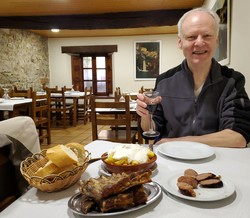
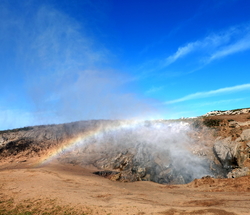
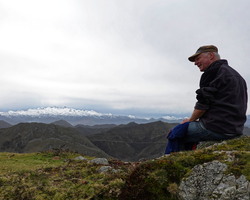
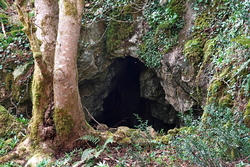
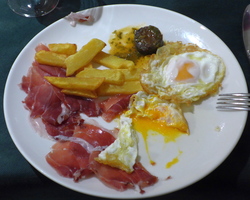
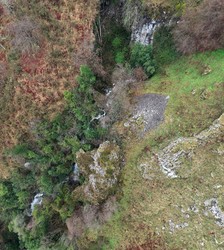
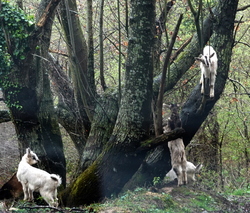
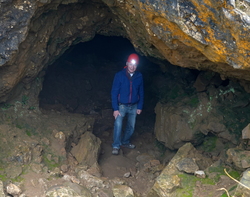
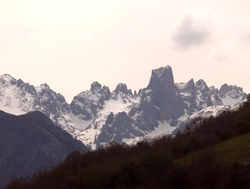
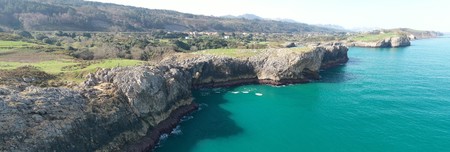
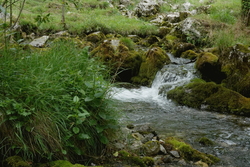
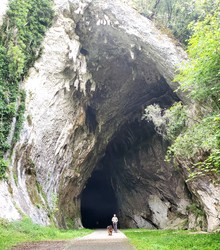
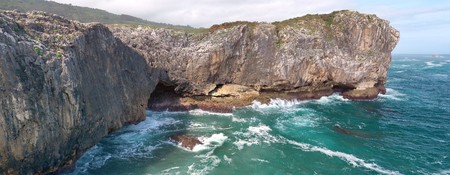
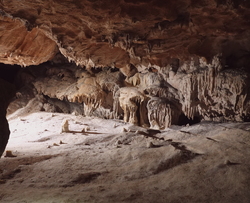
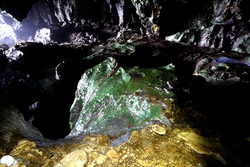
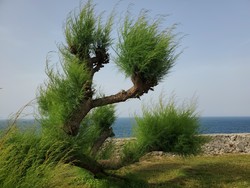
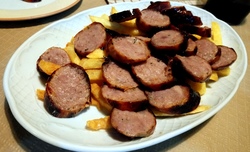
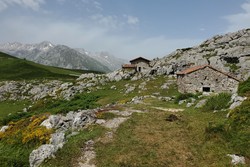
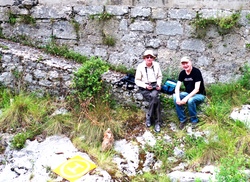
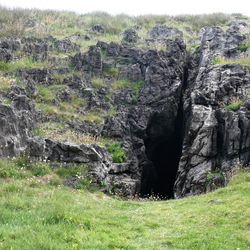
![Stream [dry in June] sinking into sea cave Stream [dry in June] sinking into sea cave](files/2022/thumb/Ballota-Bufone-0757.jpg)
